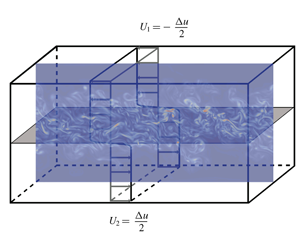Article contents
Analysis of turbulence characteristics in a temporal dense gas compressible mixing layer using direct numerical simulation
Published online by Cambridge University Press: 21 April 2020
Abstract

This study investigates the effects of a Bethe–Zel’dovich–Thompson (BZT) dense gas (FC-70) on the development of a turbulent compressible mixing layer at a convective Mach number  $M_{c}=1.1$. Three-dimensional direct numerical simulations are performed with both FC-70 and air. The initial thermodynamic state for FC-70 lies inside the inversion region where the fundamental derivative of gas dynamics (
$M_{c}=1.1$. Three-dimensional direct numerical simulations are performed with both FC-70 and air. The initial thermodynamic state for FC-70 lies inside the inversion region where the fundamental derivative of gas dynamics ( $\unicode[STIX]{x1D6E4}$) becomes negative. The complex Martin–Hou thermodynamic equation of state is used to reproduce thermodynamic peculiarities of the BZT dense gas (DG). The unstable growth phase in the mixing layer development shows an increase of
$\unicode[STIX]{x1D6E4}$) becomes negative. The complex Martin–Hou thermodynamic equation of state is used to reproduce thermodynamic peculiarities of the BZT dense gas (DG). The unstable growth phase in the mixing layer development shows an increase of  $xy$-turbulent stress tensors in DG compared to perfect gas (PG). The following self-similar period has been carefully defined from the time evolution of the integrated streamwise production and transport terms. During the self-similar stage, DG and PG mixing layers at
$xy$-turbulent stress tensors in DG compared to perfect gas (PG). The following self-similar period has been carefully defined from the time evolution of the integrated streamwise production and transport terms. During the self-similar stage, DG and PG mixing layers at  $M_{c}=1.1$ display close values of the momentum thickness growth rate, which seems similarly affected by the well-known compressibility-related reduction for PG. The same mechanisms are at stake, related to the reduction of pressure–strain terms. Turbulent kinetic energy (TKE) spectra show a slower decrease of TKE at small scales for DG compared with PG. The filtered kinetic energy equation balance developed by Aluie (Physica D, vol. 247 (1), 2013, pp. 54–65) is applied for the first time to a compressible mixing layer. The equation is reshaped to better account for TKE transport across the mixing layer. This new formulation brings out the role played by
$M_{c}=1.1$ display close values of the momentum thickness growth rate, which seems similarly affected by the well-known compressibility-related reduction for PG. The same mechanisms are at stake, related to the reduction of pressure–strain terms. Turbulent kinetic energy (TKE) spectra show a slower decrease of TKE at small scales for DG compared with PG. The filtered kinetic energy equation balance developed by Aluie (Physica D, vol. 247 (1), 2013, pp. 54–65) is applied for the first time to a compressible mixing layer. The equation is reshaped to better account for TKE transport across the mixing layer. This new formulation brings out the role played by  $\unicode[STIX]{x1D6F4}_{l}$, the pressure strengths power. A detailed comparison of the contributions to the filtered TKE equation is provided for both PG and DG mixing layers.
$\unicode[STIX]{x1D6F4}_{l}$, the pressure strengths power. A detailed comparison of the contributions to the filtered TKE equation is provided for both PG and DG mixing layers.
Information
- Type
- JFM Papers
- Information
- Copyright
- © The Author(s), 2020. Published by Cambridge University Press
References
- 14
- Cited by

